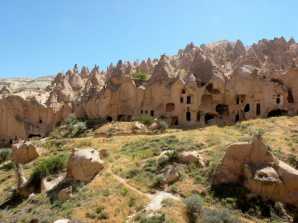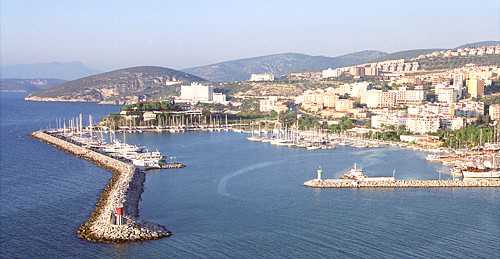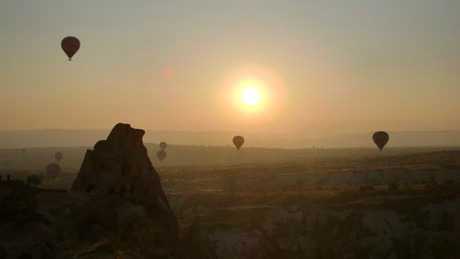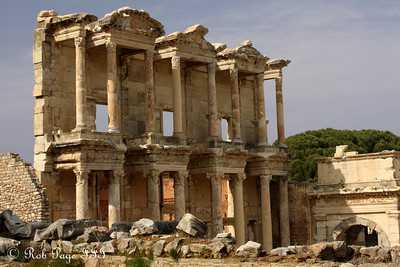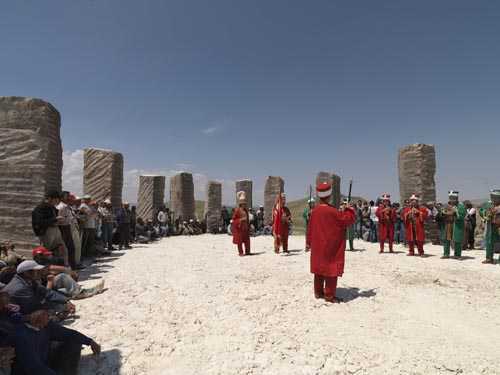It’s a heady rise, as the burly captain of our hot-air balloon fires up the ship, sending flames into the air. The balloon rises to the sky, slowly revealing the landscape of Cappadocia, a city in the interiors of Turkey, in a region called Anatolia. Brown plateaus are interspersed with grasslands, snow-covered mountain peaks from the Taurus range occupy the horizon, and the early morning sky is dotted with about 100 hot-air balloons. And, of course, you spot the curious-looking spires below, made from rock, looking as if they have windows carved into them.
The fairy chimneys, as the locals call them, are a unique geographical feature of Cappadocia.
We descend after a 45-minute balloon trip, and it’s a perfect landing, with sparkling wine waiting for us, along with wild-flower bouquets and instant photographs. After this early morning celebration, we head out, by car this time, to explore the fairy chimneys. Cappadocia is a town known for these volcanic geographic features. Long before human civilization etched villages and cities on the Anatolian landscape, volcanic lava flowed through these arid lands, leaving behind intriguing spectacles. The volcanic ash settled in layers over centuries, and as erosion took place, the softer, lower-lying rock got washed away and the harder rock on top remained, creating what looks like a slender giant wearing a big hat—Demoiselles Coiffées, to the French imagination. Then, of course, human civilization—sometimes pagans, sometimes missionaries, and sometimes the followers of Islam—walked these lands and made homes in these mountains, at times hiding, at times looting and attacking, depending on which group was more powerful at the time.

The new and the ancient:A walk down the colonnaded main street of Ephesus, an ancient Roman city. Photo: Komal Sharma/Mint
Our tour guide Emre, a blue-eyed boy, conscientiously took us through these fairy chimneys. Some were ancient churches with beautiful frescoes, converted into mosques with desecrated faces, then restored and converted into museums. The history of Cappadocia, and all of Turkey for that matter, is replete with wars, religious conflict and, of course, trade. Turkey lay on the Silk Route, on the crossroads of civilizations. The Greeks, the Ottomans, the Romans, all marched through it.
Enamoured and confused by the history of Turkey, and at how man is capable of doing things both beautiful and brutal, we return to our hotel, the Museum, which works as a trip in itself. A boutique hotel sitting on top of a hill, it is built within and around a multitude of fairy chimneys and old structures that have been preserved, turning them into lounges and luxurious suites. The main deck is on the edge of a cliff, with an infinity pool and half-broken Greek stone arches. The view is an empty road meandering through the plateaus and a crimson horizon in the distance.

A tree atop the Pigeon Valley in Cappadocia, with the characteristic Turkish evil eyes tied to it. Photo: Komal Sharma/Mint.
Two days later, from this brown land of cobbled streets and the quaint countryside of Anatolia, we take a flight to the more flamboyant west coast. We land in Izmir, a town which was a stopover on the Silk Route, and take a 2-hour drive to Kusadasi, a cute honeymoon town. With the emerald blue waters of the Aegean Sea, cruise liners, Mediterranean islands in the distance, young couples on scooters and 1970s convertibles, romance is in the Kusadasi air. But that’s not all; for, it’s also the base town for visiting the ancient Greek sites of Ephesus, Aphrodisias, Miletus, and others.
Before we head out again for our history lesson, we stop at a seaside restaurant, with rickety chairs kept right on the shore, the waves washing up our heels and rows of cats waiting wide-eyed for us to throw them some balik. That’s the menu, balik (fish), lots of salata (green leafy salad), button mushrooms stuffed with peynir (cottage cheese) and baked in clay pots, and, of course, bira (beer). It’s only apt that Theobroma (food of the gods) is a word of Greek origin.
Graphic: Ahmed Raza Khan/Mint
Our tour guide for the day, Gulsum, decided to start us off with the charming little Greek village of Sirince. Old Greek women, who stayed behind after the population exchange of 1923—when ethnic Greeks left for Greece—hold a flea market selling apple wine and apricots, crochet table linen, cotton dresses, turquoise jewellery, and freshly picked berries. Nobody speaks English, but it’s easy to pick up a little Turkish with a whole range of words very similar to Hindustani. Dukkan (shop), sebzi (vegetables), duniya (world), kitap (kitab or book) are a few examples.
One of the shopkeepers explained their greeting, meherabba. “In olden times, when two people used to meet in a desert, they said meherabba to each other, meaning, I am not your enemy, I come in peace.”
For the next two days, we were on the road, exploring ancient cities. We walked down the colonnaded main street in Ephesus, saw what remains of the Temple of Artemis, the massive stadiums—Gulsum informed us that stadiums with a significant depth were for gladiator fights; others were for the non-violent performing arts—the agoras (marketplaces), the Temple of Apollo and larger than life sculptures of Medusa and Nike, still standing after all these years. It feels like time travel, a journey into another era.
These are some of the best preserved archaeological sites in the world, and they hint at the scale and grandeur with which people in the Hellenistic era lived.
However, grandeur is only one side of the coin. As the day passes listening to Gulsum narrate stories of Roman emperors, the defence of the Seljuks, or the invasions of Muslim rulers, one is compelled to believe that whole cities were built either to assert power, or for self-preservation, or to propagate religions and the gods.
But in the process of occupying and killing, for vengeance or honour, things of great beauty were built, razed and rebuilt.



